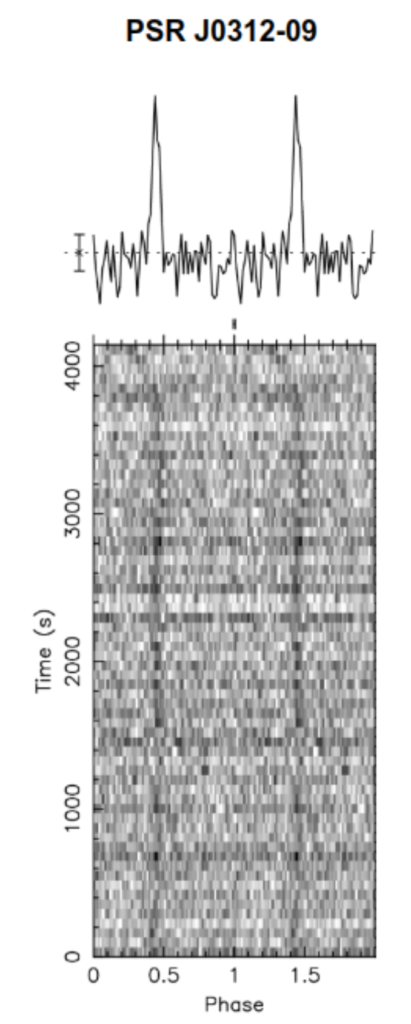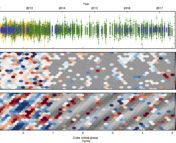
The undergrad research series is where we feature the research that you’re doing. If you’ve missed the previous installments, you can find them under the “Undergraduate Research” category here.
Are you doing an REU this summer? Were you working on an astro research project during this past school year? If you, too, have been working on a project that you want to share, we want to hear from you!
************
Shawaiz Tabassum recently graduated from New York University Abu Dhabi and is now a research assistant at the same institute. This research was done for his senior year thesis under the guidance of his advisor Professor Mallory Roberts. He has presented this research at multiple conferences, including the 235th AAS Meeting.
The Large Area Telescope (LAT) aboard the Fermi Satellite has identified 5064 gamma-ray sources since its launch in 2008. Most of these sources have been identified as blazars (a type of Active Galactic Nuclei) or pulsars. However, about a thousand of these sources still remain unassociated with a physical counterpart. It is believed that these sources could be Millisecond Pulsars (MSPs). MSPs rotate extremely fast and emit beams of electromagnetic radiation, like a stellar lighthouse. If these beams are directed towards the Earth, we see regular pulses of radiation at a fixed period of less than 40 milliseconds, meaning MSPs act as very precise clocks. Most MSPs are known to be in binary systems where they orbit a white dwarf companion. As the MSP orbits the white dwarf, its pulsed emission is Doppler shifted, modifying the measured duration of the pulses.
Detecting such binary systems conventionally accounted for this Doppler shift using ‘acceleration searches’, looking for changes in the period over time, (dP/dt). This method has been available as part of the PRESTO pulsar search software for almost two decades. However, it is only effective when the observation time is less than 1/10th of the orbital period. Beyond this, the assumption of constant acceleration is inadequate.
We have been using the novel jerk search algorithm implemented in the PRESTO software package to re-search Fermi sources that remain unidentified. While acceleration searches look for changes in the period over time (dP/dt), jerk searches look for changes in the acceleration over time, (d2P/dt2). Jerk searches result in increased sensitivity to tight binary systems, probing a parameter space scarcely searched before. We used radio observations of unassociate sources in the Fermi LAT catalogs to search for a class of binary MSPs known as “spiders”. These systems have orbital periods of less than a day and are further divided into two classes based on companion mass (Mc): “black widows” where Mc << 0.1M☉ and “redbacks” where Mc > 0.2M☉. The observations were done using the Green Bank Telescope (GBT) at 820 MHz.
We discovered 4 MSPs as a result of searching 62 sources. Two of the discovered MSPs show significant acceleration, indicating they are in binary systems. One of these MSPs, PSR J0312-09, is in a tight binary with an orbital period of just ~2.2 hours and a companion of mass of less than 0.1M☉, identifying it as a black widow. This system was discoverable only using a jerk search, as the signal is weak when using only an acceleration search on the original data.
These discoveries are being followed up through timing observations with the Giant Metrewave Radio Telescope (GMRT) and the GBT. Timing observations are observations taken at a specific cadence in order to get the time of arrivals (TOAs) for pulses. These observations will allow us to do timing analysis for these pulsars and derive important properties such as orbital parameters, accurate positions, spin parameters, total energy output, magnetic field strengths, and characteristic ages.

Figure: The plot from PRESTO for PSR J0312-09, which shows drifting in phase over time even after accounting for the jerk. The bottom panel is a waterfall plot where the Y-axis is the time in seconds and the X-axis is the phase of the pulsar’s rotation. Each grey square represents a bin, where darkness represents the signal strength. The darkest region drifts in phase over time, showing the period between pulses received on Earth changes due to orbiting its white dwarf companion. At the top we have the pulsar profile where each column of the waterfall has been integrated to show the strength of signal along the phase.
If you are an undergraduate that took part in an REU this summer and would like to share your research on Astrobites, please click here and use the form to submit a brief (fewer than 200 words) write-up of your work. The target audience is one familiar with astrophysics but not necessarily your specific subfield, so write clearly and try to avoid jargon. Feel free to also include either a visual regarding your research or else a photo of yourself.




